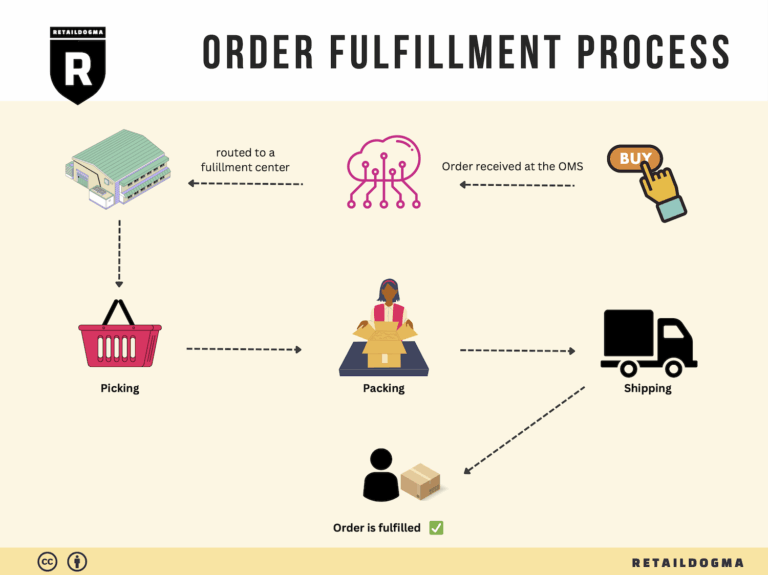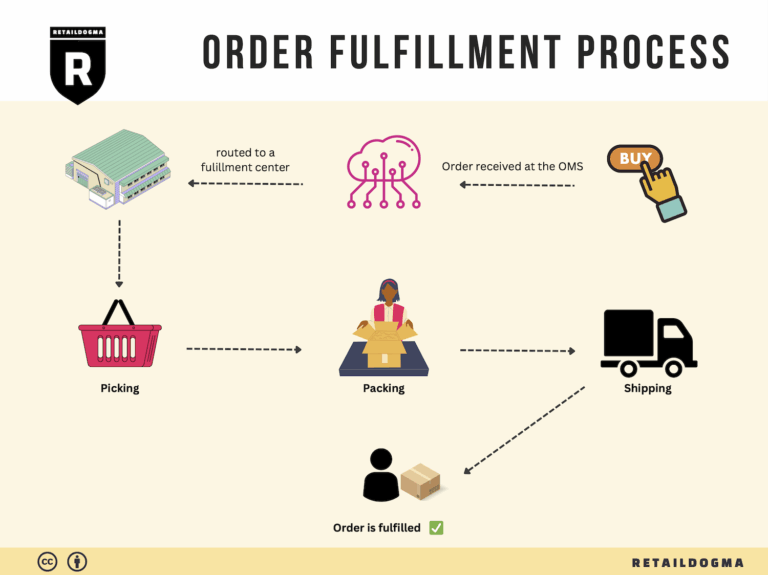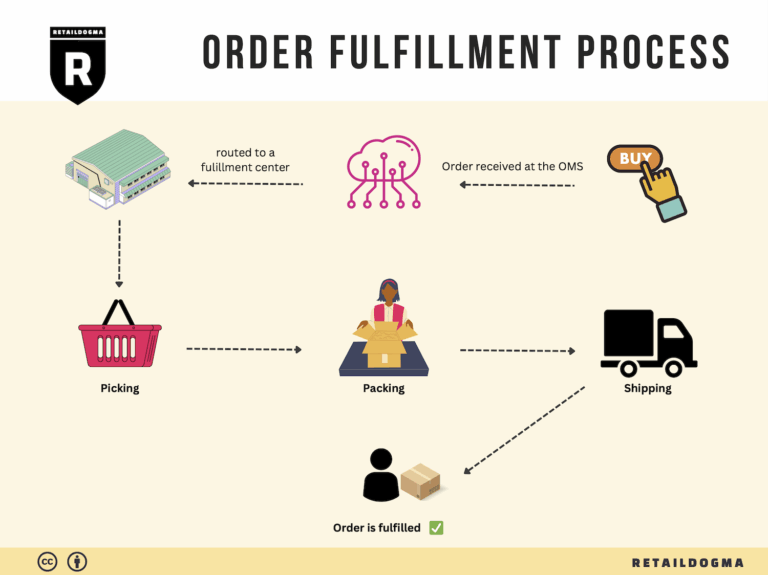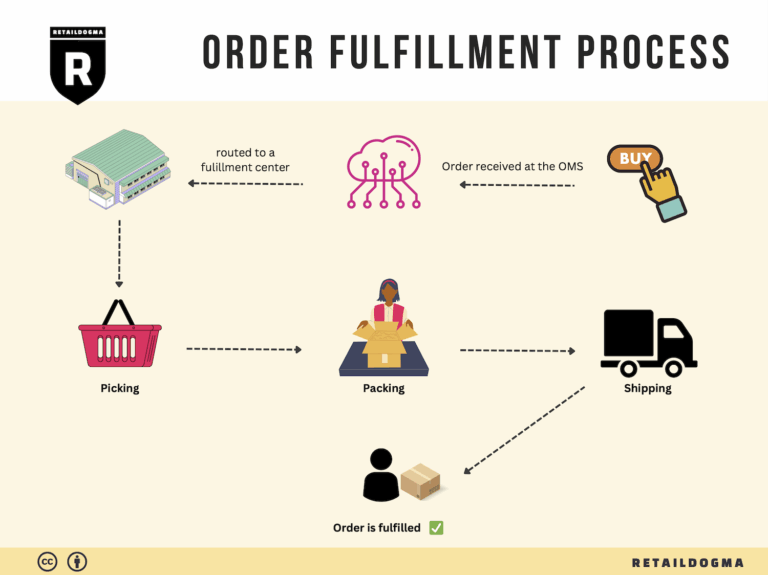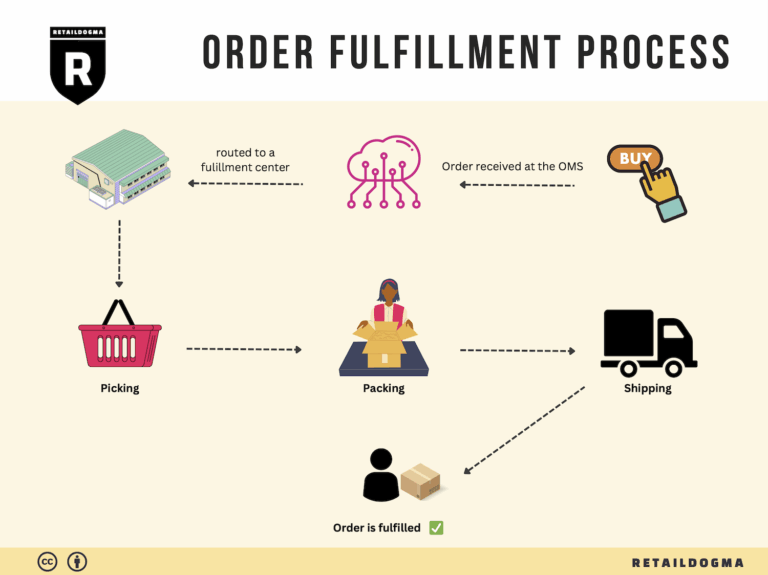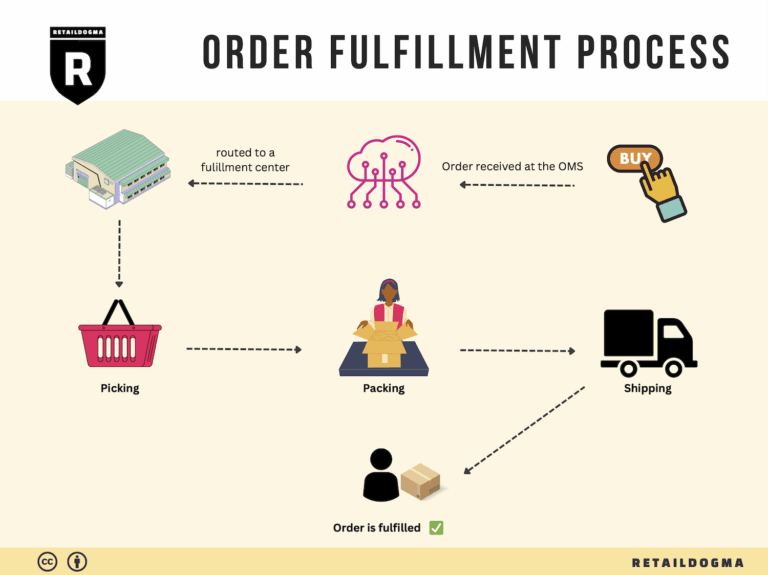What Is A Fulfillment Center? A Complete Guide (2025)
What is E-commerce Fulfillment? An Introduction for Growing Businesses
Overcoming Fulfillment Challenges in E-commerce
As an e-commerce business owner, you may find yourself grappling with the complexities of packing and shipping orders, especially as your sales volume grows. Managing these logistics can quickly become overwhelming, diverting your focus from scaling your business and enhancing customer experience. This is where effective e-commerce fulfillment comes into play—it is the backbone of your operations, ensuring that products reach your customers efficiently and accurately.
Fulfillment, in simple terms, refers to the entire process of getting a product from your warehouse to your customer’s doorstep. It encompasses receiving inventory, processing orders, packing items, and managing shipping logistics. For growing businesses, mastering this process is essential for maintaining customer satisfaction and operational efficiency.
In this guide, we will explore the various models of e-commerce fulfillment, including Third-Party Logistics (3PL) and Fulfillment by Amazon (FBA). Each model offers distinct advantages and may suit different business needs. Understanding these options will help you make informed decisions about which fulfillment method aligns with your growth strategy.
Additionally, we will cover the core services associated with e-commerce fulfillment, such as order management, inventory control, and shipping solutions. These services are crucial for maintaining streamlined operations and ensuring that orders are fulfilled accurately and promptly.
Choosing the right fulfillment partner is another critical aspect we will address. We will provide practical tips on evaluating potential partners based on their industry expertise, service offerings, scalability, technology, and geographic reach. Selecting a reliable partner can significantly impact your business’s efficiency and customer satisfaction.
Finally, we will delve into pricing considerations for e-commerce fulfillment services. Understanding the cost structure of various fulfillment options will empower you to budget effectively and choose a solution that delivers value without compromising service quality.
The ultimate goal of this guide is to equip you with the knowledge and insights necessary to navigate the complexities of e-commerce fulfillment. By making informed decisions about your logistics, you can focus on what truly matters: growing your business and delighting your customers.
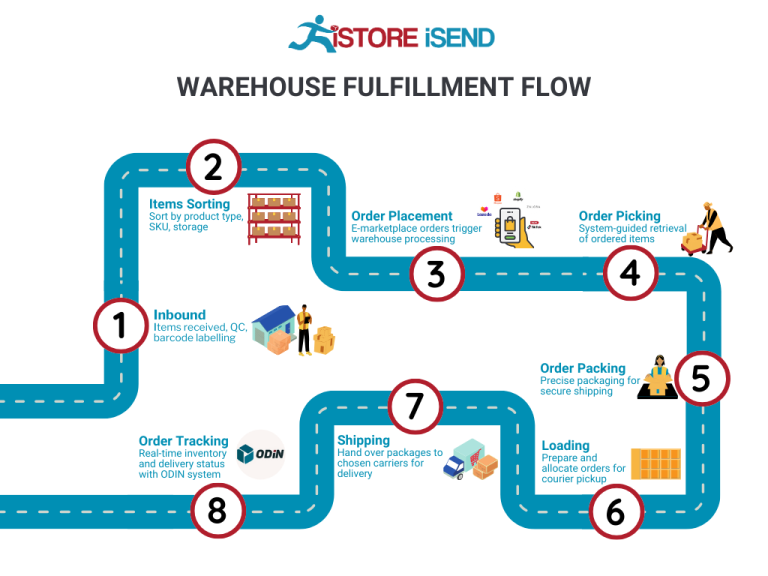
What You’ll Learn In This Guide
- What is E-commerce Fulfillment? An Introduction for Growing Businesses
- The Order Fulfillment Process: From ‘Buy’ Button to Customer’s Door
- Comparing Fulfillment Models: In-House vs. 3PL vs. Dropshipping
- A Deep Dive into Amazon FBA: Pros, Cons, and Who It’s For
- Core Services Offered by Fulfillment Centers
- How to Choose a Fulfillment Partner: A 6-Point Checklist
- Understanding Fulfillment Pricing: A Breakdown of Common Fees
- Frequently Asked Questions (FAQs) about Fulfillment
- Conclusion: Is Outsourcing Fulfillment the Right Move for Your Business?
- Important Disclaimer
The Order Fulfillment Process: From ‘Buy’ Button to Customer’s Door
1. Receiving Inventory
The first step in the order fulfillment process is receiving inventory. This involves the acceptance of goods into the warehouse from suppliers or manufacturers. Upon arrival, the items are checked against purchase orders to confirm that the correct quantities and products have been delivered. This step is crucial because accurate receiving ensures that inventory records are up-to-date, which is essential for fulfilling future orders without delays.
Key term: SKU (Stock Keeping Unit) – This unique identifier helps track inventory levels and facilitates efficient management of stock.
Implementing an effective receiving process can reduce discrepancies and improve inventory accuracy. It often involves the use of barcodes or RFID technology to streamline the verification process, allowing for quick updates to inventory management systems. Maintaining a meticulous receiving protocol helps prevent stockouts and overstock situations, setting a solid foundation for subsequent steps in the fulfillment process.
2. Warehouse Storage
Once inventory is received, the next step is warehouse storage. This involves organizing and storing goods in a manner that maximizes space and minimizes retrieval time. Effective storage solutions can include shelving systems, pallets, and bins, all strategically placed to enhance accessibility.
The importance of efficient warehouse storage cannot be overstated. Proper organization allows for quick identification and retrieval of items when orders are placed, thus expediting the order fulfillment process. An optimized storage layout can also reduce labor costs and improve safety within the warehouse.
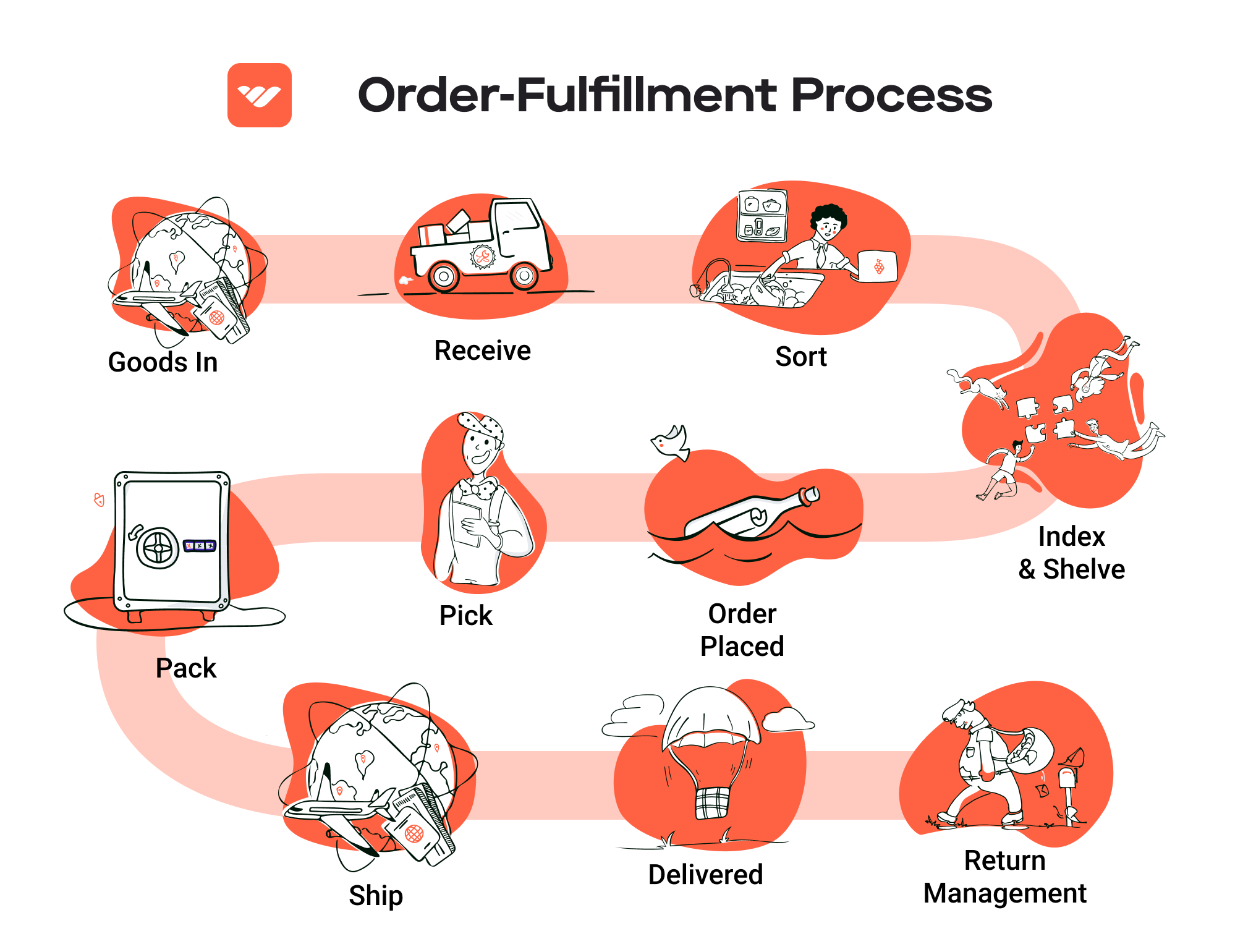
Key term: ABC Analysis – This inventory categorization technique divides stock into three categories (A, B, and C) based on importance and value, helping prioritize storage and retrieval efforts.
Implementing a systematic approach to warehouse storage ensures that high-demand items are easily accessible, while slower-moving products are stored in less accessible areas. This strategic organization ultimately leads to faster order processing times and improved customer satisfaction.
3. Order Picking
Order picking is the process of selecting items from the warehouse to fulfill customer orders. This step is often guided by pick lists, which outline the specific products and quantities needed for each order. Efficient order picking is critical to minimizing errors and ensuring that customers receive exactly what they ordered.
The significance of effective order picking lies in its direct impact on fulfillment speed and accuracy. A well-executed picking process can drastically reduce the time it takes to prepare an order for shipping. Various picking methods, such as single order picking, batch picking, or zone picking, can be employed based on the size and complexity of the orders.
Key term: Pick List – This document serves as a guide for warehouse staff, detailing the items to be retrieved for each order, thus streamlining the picking process.
By investing in training for staff and utilizing technology such as pick-to-light systems or mobile devices, businesses can enhance the efficiency of their order picking process, leading to reduced lead times and improved overall fulfillment performance.
4. Order Packing
After items are picked, they move to the order packing stage. This step involves carefully packaging the products to ensure they arrive at the customer’s location in perfect condition. Proper packing includes selecting appropriate packaging materials, labeling shipments accurately, and including any necessary documentation, such as invoices or return instructions.
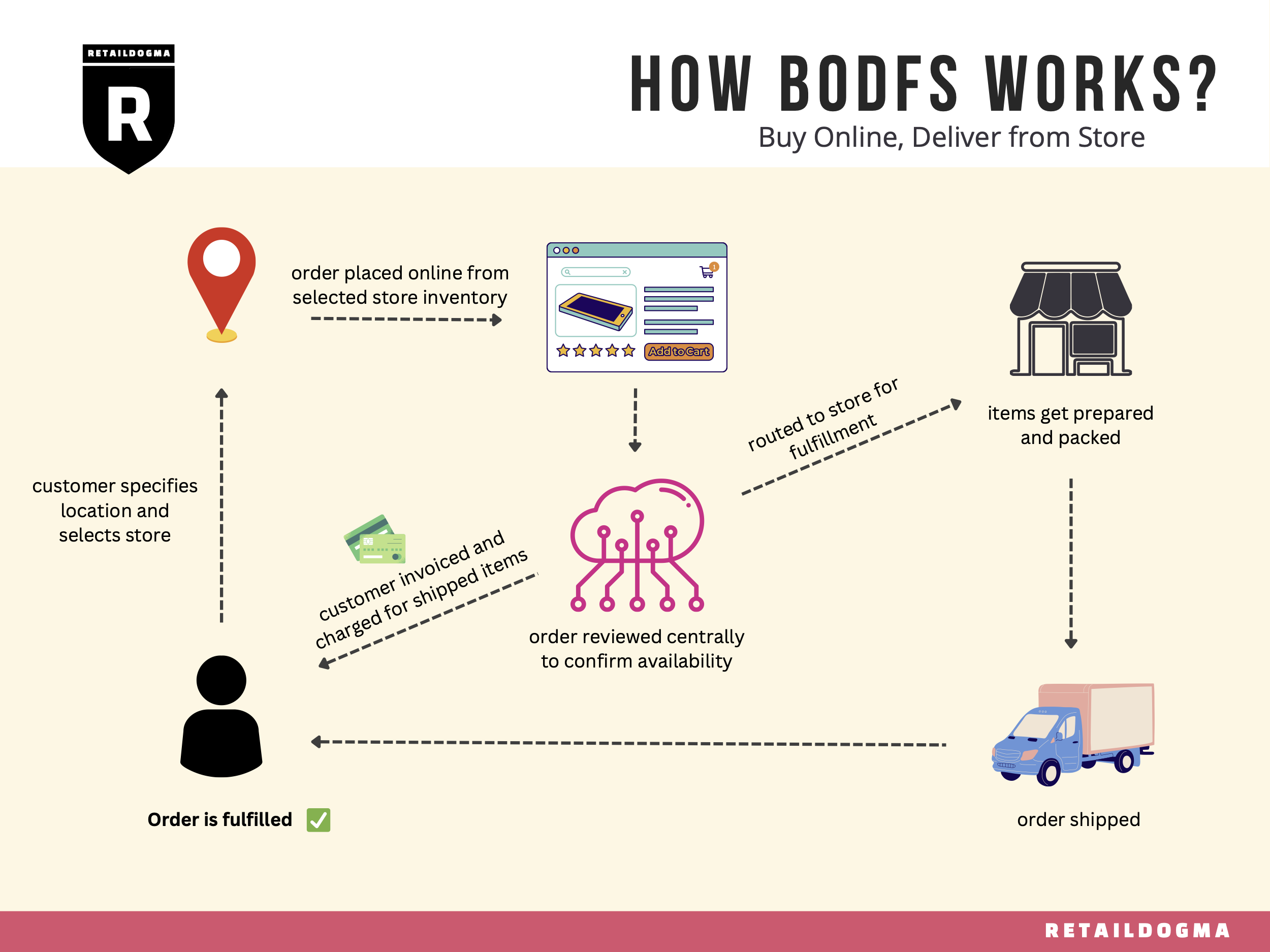
The importance of thorough order packing cannot be understated. Well-packed orders reduce the likelihood of damage during transit and enhance the customer experience. Additionally, accurate labeling ensures that packages are routed correctly, minimizing the risk of delivery errors.
Key term: Packing Slip – This document accompanies the shipment and lists the items included in the order, serving as a verification tool for both the sender and recipient.
Investing in quality packing materials and training staff on packing best practices can significantly reduce return rates due to damages and improve customer satisfaction with the delivery process.
5. Shipping & Delivery
The final step in the order fulfillment process is shipping and delivery. This involves selecting the appropriate carrier, generating shipping labels, and dispatching the packages. It’s essential to choose a reliable shipping partner that aligns with your business’s delivery needs and customer expectations.
The importance of this step is twofold: timely delivery is critical for customer satisfaction, and effective shipping management can significantly impact operational costs. Businesses must also track shipments to provide real-time updates to customers, enhancing transparency and trust.
Key term: Service Level Agreement (SLA) – This contract outlines the expected delivery timelines and service standards between the business and the carrier, ensuring accountability.
By implementing robust shipping strategies, such as route optimization and using multiple carriers, businesses can enhance delivery efficiency and reduce costs. This final step in the fulfillment process is pivotal in creating a positive customer experience and fostering long-term loyalty.
Comparing Fulfillment Models: In-House vs. 3PL vs. Dropshipping
Fulfillment Model Comparison
| Model | Who Handles Inventory | Best For (Business Stage) | Key Advantage | Key Disadvantage |
|---|---|---|---|---|
| In-House Fulfillment | The business itself | Established businesses with stable demand | Full control over inventory and processes | High operational costs and overhead |
| Third-Party Logistics (3PL) | The 3PL provider | Growing businesses and startups | Scalable solutions with expertise | Less control over logistics |
| Dropshipping | Supplier or manufacturer | New businesses and small retailers | Low overhead and no inventory risk | Lower profit margins and longer shipping times |
In-House Fulfillment
In-house fulfillment involves managing the entire logistics process internally. This model is typically utilized by established businesses that have consistent and predictable order volumes. Companies that choose in-house fulfillment have complete control over their inventory, order processing, and shipping. This can lead to enhanced customer service, as businesses can tailor their operations to meet specific customer needs and preferences. However, maintaining an in-house operation can be costly. Businesses must invest in warehousing, staffing, and technology, which can create significant overhead. Additionally, as order volumes fluctuate, the business may struggle with excess inventory or fulfillment bottlenecks, making it less agile in responding to market changes.
Third-Party Logistics (3PL)
Third-party logistics (3PL) involves outsourcing fulfillment processes to specialized providers. This model is particularly advantageous for growing businesses and startups that may not have the resources to manage logistics in-house. 3PL providers offer scalable solutions, allowing businesses to expand their operations without the burden of investing in infrastructure or staffing. By leveraging the expertise of a 3PL, companies can benefit from advanced technology, optimized shipping routes, and comprehensive inventory management systems. However, the trade-off is a potential loss of control over logistics operations. Businesses may face challenges in communication and coordination, which can impact service levels. Moreover, costs can accumulate over time, particularly if the 3PL provider charges fees for various services.
Dropshipping
Dropshipping is a fulfillment model where the retailer does not hold inventory but instead relies on suppliers or manufacturers to ship products directly to customers. This model is particularly appealing for new businesses and small retailers looking to minimize upfront costs and inventory risk. The primary advantage of dropshipping is the low overhead; businesses do not need to invest in warehousing or inventory management. Additionally, it allows for a broad product offering without the financial burden of stocking items. However, dropshipping comes with its drawbacks. Profit margins can be slimmer due to reliance on suppliers, and shipping times may be longer, which can lead to customer dissatisfaction. Businesses also have limited control over product quality and fulfillment speed, making it critical to partner with reliable suppliers.
Conclusion
Choosing the right fulfillment model is a crucial decision that can significantly impact your e-commerce business’s scalability and operational efficiency. In-house fulfillment provides control but can be cost-prohibitive, especially for smaller businesses. Third-party logistics offer scalability and expertise, ideal for those looking to grow without heavy investments in logistics infrastructure. Dropshipping presents an excellent opportunity for new entrants to the market, but it requires careful supplier management to ensure customer satisfaction. Ultimately, the best model depends on your specific business needs, growth trajectory, and the resources available to you.
A Deep Dive into Amazon FBA: Pros, Cons, and Who It’s For
Understanding Fulfillment by Amazon (FBA)
Fulfillment by Amazon (FBA) is a service provided by Amazon that enables sellers to store their products in Amazon’s fulfillment centers. Amazon then takes care of storage, packaging, and shipping of products directly to customers. This service allows sellers to leverage Amazon’s extensive logistics network and customer service, enhancing their ability to compete in the e-commerce landscape.
When a customer places an order for a product fulfilled by FBA, Amazon picks, packs, and ships the product, while also managing customer service and returns. Sellers can also benefit from the exposure of their products to Amazon’s vast customer base, often leading to increased sales.
How FBA Works
-
Set Up Your Account: To use FBA, sellers must create an Amazon Seller Central account and select FBA as their fulfillment method.
-
Prepare Your Products: Products need to be prepared according to Amazon’s guidelines, which include packaging and labeling requirements.
-
Ship Products to Amazon: Sellers send their products to Amazon’s fulfillment centers. Amazon provides shipping plans to guide sellers on where to send their inventory.
-
Storage and Inventory Management: Once received, Amazon stores the products in its warehouses. Sellers can monitor their inventory levels through Seller Central.
-
Order Processing: When a customer places an order, Amazon handles the picking, packing, and shipping of the product.
-
Customer Service: Amazon manages all customer inquiries and returns, providing a seamless experience for both sellers and buyers.
-
Payment: After the sale, Amazon processes payments and deposits the seller’s earnings into their account, minus applicable fees.
Pros of Using FBA
-
Prime Eligibility: Products fulfilled through FBA are eligible for Amazon Prime, which can significantly increase visibility and attract more customers who prefer the fast and free shipping options that Prime offers.
-
Customer Trust: Leveraging Amazon’s brand reputation fosters trust among potential buyers. Customers often feel more secure purchasing products that are backed by Amazon’s customer service and return policies.
-
Multi-Channel Fulfillment: FBA allows sellers to fulfill orders from other sales channels (e.g., eBay, their own website) using Amazon’s logistics network, providing flexibility and efficiency in managing inventory and shipping.
-
Scalability: FBA can accommodate growth. As sales increase, sellers can scale their operations without needing to invest in their own warehousing and logistics infrastructure.
-
Reduced Administrative Burden: By outsourcing fulfillment, sellers can focus on other critical aspects of their business, such as product development, marketing, and customer engagement.
Cons of Using FBA
-
High Fees: FBA comes with various fees, including storage fees, fulfillment fees, and additional costs for long-term storage. These can eat into profit margins, especially for low-cost items or products with slow turnover.
-
Strict Inventory Rules: Amazon has stringent policies regarding inventory management. Sellers must adhere to guidelines on product condition, packaging, and labeling. Failure to comply can lead to penalties or account suspension.
-
Commingling Risks: FBA utilizes a commingling system where products from different sellers may be stored together. This poses a risk if a seller’s inventory is mixed with defective or counterfeit products, potentially harming their reputation and customer satisfaction.
-
Limited Control Over Shipping: Sellers relinquish control over the fulfillment process. While Amazon handles logistics efficiently, sellers may have concerns about how their products are handled and delivered.
-
Dependency on Amazon: Relying on FBA can create a dependency on Amazon’s platform, which may limit a seller’s ability to diversify their sales channels and customer base.
Who is FBA Best For?
Fulfillment by Amazon can be an excellent option for a variety of sellers, particularly:
-
Small to Medium-Sized Businesses: Companies that lack the infrastructure to manage their own fulfillment operations can benefit greatly from the scale and efficiency of Amazon’s logistics.
-
New Sellers: Entrepreneurs just starting in e-commerce can leverage FBA to gain visibility and credibility without the burden of managing logistics.
-
Sellers with High Sales Volumes: Businesses experiencing rapid growth can utilize FBA to scale their operations quickly without needing to invest heavily in logistics.
-
Businesses with Seasonal Demand: Companies that experience fluctuating demand can benefit from the flexibility of FBA, allowing them to scale their inventory up or down without the overhead of maintaining their own warehouse.
-
Brands Looking to Enhance Visibility: Sellers aiming to reach a larger audience and improve sales through Amazon’s marketplace can take advantage of the trust and convenience associated with FBA.
In conclusion, while Fulfillment by Amazon offers numerous advantages such as Prime eligibility and customer trust, it is essential for sellers to weigh these benefits against the potential downsides, including high fees and strict inventory rules. Understanding the intricacies of FBA will enable e-commerce businesses to make informed decisions about their fulfillment strategies, ultimately leading to sustainable growth and success in the competitive online marketplace.
Core Services Offered by Fulfillment Centers
Inventory Management & Warehousing
Inventory management and warehousing form the backbone of any effective fulfillment operation. This service involves the systematic tracking, storage, and handling of products within a warehouse environment. Fulfillment centers utilize sophisticated inventory management systems that provide real-time visibility into stock levels, enabling businesses to maintain optimal inventory levels and prevent stockouts or overstock situations.
Benefits to E-commerce Businesses:
-
Enhanced Efficiency: With automated inventory tracking, businesses can streamline their operations, reducing the time spent on manual stock checks and minimizing errors in order processing.
-
Cost Control: Effective inventory management helps reduce holding costs and ensures that capital is not tied up in excess stock. This is particularly important for B2B transactions, where order volumes are larger, and the financial stakes are higher.
-
Scalability: As businesses grow, their inventory needs change. Fulfillment centers provide scalable warehousing solutions, allowing businesses to expand or contract their inventory space as needed without the headache of managing physical facilities.
-
Improved Customer Satisfaction: With accurate inventory data, businesses can provide reliable delivery timelines and avoid disappointing customers with backorders, thus enhancing overall satisfaction and loyalty.
Pick and Pack Services
Pick and pack services refer to the process of selecting items from inventory (picking) and preparing them for shipment (packing). Fulfillment centers employ efficient order picking techniques, often utilizing technology such as barcode scanners and automated picking systems to ensure accuracy and speed. Once picked, items are carefully packed to minimize damage during transit.
Benefits to E-commerce Businesses:
-
Speedy Fulfillment: By leveraging advanced picking systems, fulfillment centers can significantly reduce order processing times, allowing businesses to meet customer expectations for fast delivery.
-
Accuracy: Automated systems decrease the likelihood of human error during order picking and packing, ensuring that customers receive exactly what they ordered, which is crucial for maintaining trust and satisfaction.
-
Cost Efficiency: Optimized packing processes can reduce shipping costs by maximizing space utilization and minimizing material waste, thus enhancing profitability.
-
Customization: Many fulfillment centers offer customizable packing options, enabling businesses to enhance their branding through personalized packaging, which can improve customer experience and foster brand loyalty.
Kitting and Assembly
Kitting and assembly services involve the grouping of individual items into a ready-to-ship set or the assembly of products before they are sent to customers. This service is particularly valuable for e-commerce businesses that offer bundled products or require assembly prior to delivery, such as furniture or electronics.
Benefits to E-commerce Businesses:
-
Streamlined Operations: By outsourcing kitting and assembly to fulfillment centers, businesses can focus on their core competencies, reducing the burden of managing complex logistics in-house.
-
Enhanced Product Offerings: Kitting allows businesses to offer bundled products or special promotions that can attract customers and increase average order value. This can lead to higher sales and improved competitive positioning.
-
Quality Control: Fulfillment centers often have rigorous quality control processes in place, ensuring that assembled products meet specific standards before they are shipped, which can reduce returns and enhance customer satisfaction.
-
Flexibility: Businesses can quickly adapt to market demands by creating new kits or bundles without investing in additional labor or equipment, thus maintaining agility in a rapidly changing marketplace.
Returns Management (Reverse Logistics)
Returns management, or reverse logistics, encompasses the processes involved in handling returned products. Fulfillment centers provide essential services for managing returns efficiently, including inspection, restocking, and processing refunds or exchanges. This service is crucial for maintaining customer satisfaction and loyalty in e-commerce.
Benefits to E-commerce Businesses:
-
Customer Retention: A streamlined returns process can enhance customer trust and satisfaction. When customers know that returning an item is hassle-free, they are more likely to make purchases, knowing they have options.
-
Cost Reduction: Efficient returns management minimizes the costs associated with returns, such as restocking fees and lost inventory. Fulfillment centers can optimize this process, ensuring that returned products are quickly assessed and reintroduced into inventory.
-
Data Insights: Returns management provides valuable insights into customer preferences and product quality. Analyzing return reasons can help businesses improve product offerings and reduce future returns, ultimately enhancing profitability.
-
Sustainability: Many fulfillment centers are adopting sustainable practices in their reverse logistics processes, including recycling and responsible disposal of returned items. This not only reduces waste but also aligns with the growing consumer demand for environmentally friendly practices.
In conclusion, partnering with a capable fulfillment center can significantly enhance an e-commerce business’s operational efficiency, customer satisfaction, and scalability. By leveraging core services such as inventory management, pick and pack, kitting and assembly, and returns management, businesses can focus on growth and innovation while ensuring seamless order fulfillment.
How to Choose a Fulfillment Partner: A 6-Point Checklist
Location & Warehouse Network
Importance:
The geographical location of your fulfillment partner’s warehouses plays a crucial role in your ability to meet customer expectations. Proximity to your customer base can reduce shipping times and costs, ultimately enhancing customer satisfaction.
Questions to Ask:
– What is the geographic reach of your warehouse network?
– How many warehouses do you operate, and where are they located?
– Can you provide insights into your shipping zones and typical delivery times for various regions?
– How do you manage inventory across multiple locations to ensure efficiency?
Technology & Integrations
Importance:
In today’s digital landscape, the technology used by your fulfillment partner can significantly impact your operations. Advanced technology enables real-time tracking, inventory management, and seamless integration with your e-commerce platform, enhancing overall efficiency.
Questions to Ask:
– What order management system (OMS) do you use, and how does it integrate with my e-commerce platform?
– Do you offer real-time inventory visibility? If so, how is this information communicated?
– Can your systems support automation in order processing and shipping?
– What kind of reporting and analytics capabilities do you provide?
Specializations (e.g., Cold Storage, Oversized Items)
Importance:
Different products have different storage and shipping requirements. If your business deals with specific types of goods—such as perishables or oversized items—it’s essential to partner with a fulfillment provider that specializes in those areas to ensure proper handling.
Questions to Ask:
– Do you have specialized facilities for unique product categories (e.g., cold storage, hazardous materials)?
– What are your capabilities for handling oversized or heavy items?
– Can you customize packaging or shipping solutions for specialized products?
– How do you ensure compliance with industry regulations for specific types of goods?
Scalability & Capacity
Importance:
As your business grows, your fulfillment needs will change. A partner that can scale operations up or down will help you maintain efficiency and minimize costs during fluctuations in demand, such as seasonal spikes.
Questions to Ask:
– How do you handle fluctuations in order volume? Can you provide examples from past clients?
– What is your capacity for storage and order fulfillment during peak seasons?
– Are there any limitations on the types of products you can store or fulfill?
– How quickly can you scale operations in response to my business growth or seasonal demands?
Pricing and Contracts
Importance:
Understanding the pricing structure and contract terms of your fulfillment partner is essential for budgeting and financial planning. Transparent pricing helps avoid unexpected costs that can impact your profitability.
Questions to Ask:
– Can you provide a detailed breakdown of your pricing model, including shipping, storage, and additional fees?
– What are the terms of your contracts? Are there any long-term commitments or penalties for early termination?
– How do you handle price adjustments, and what factors would trigger a change in pricing?
– Are there volume discounts or incentives for long-term contracts?
Customer Support & Reviews
Importance:
Reliable customer support is vital for addressing any issues that arise during the fulfillment process. A partner’s reputation can provide insights into their reliability and service quality.
Questions to Ask:
– What customer support options do you offer (e.g., phone, email, chat), and what are your response times?
– Can you provide references or case studies from clients in my industry?
– How do you handle issues like order discrepancies or shipping delays?
– What is your process for gathering and acting on customer feedback?
Conclusion
Choosing the right fulfillment partner is a critical decision that can influence your business’s operational efficiency and customer satisfaction. By following this checklist and asking the right questions, you can ensure that you select a partner that aligns with your business goals and can support your growth in the competitive e-commerce landscape. Take the time to evaluate potential partners thoroughly, and invest in a relationship that will enhance your fulfillment operations and contribute to your overall success.
Understanding Fulfillment Pricing: A Breakdown of Common Fees
Initial Setup Fees
Initial setup fees are one-time charges that cover the costs associated with onboarding your business to a fulfillment provider’s system. This may include the integration of your e-commerce platform with the fulfillment center’s technology, the configuration of inventory management systems, and any necessary training for your team. The fee can vary significantly based on the complexity of your operations, the number of SKUs (stock-keeping units) you intend to manage, and the level of customization required. Generally, you should expect to pay anywhere from a few hundred to several thousand dollars, depending on the scale of services you are utilizing.
Receiving Fees
Receiving fees are incurred when the fulfillment center accepts and processes your inventory. This fee is typically calculated based on the volume of goods received, measured in either pallets or units. For example, you might pay a fixed rate per pallet unloaded, or a fee based on the number of individual items processed. This fee can also encompass quality checks, sorting, and labeling items before they are added to the inventory. Businesses should consider the frequency and volume of shipments when estimating this cost, as it can add up quickly, especially for those with high turnover rates.
Storage Fees (per pallet/bin)
Storage fees are charged for the space your inventory occupies within the fulfillment center. These fees can be calculated on a per-pallet or per-bin basis and typically depend on the duration of storage. For instance, you might be charged a monthly fee for each pallet stored, which can range from $10 to $50, depending on the provider and the location of the warehouse. Additionally, some providers may implement tiered pricing, where the cost decreases as your storage volume increases. Understanding your inventory turnover rates will help you manage these costs effectively, as prolonged storage can lead to higher fees.
Pick & Pack Fees (per item/order)
Pick and pack fees cover the labor and materials required to retrieve items from storage and prepare them for shipment. These fees are generally charged per item or per order, with costs varying based on the complexity of the order. For example, picking a single item may incur a lower fee than an order containing multiple products that require special packaging or assembly. Fees can range from $0.50 to $5.00 per item, depending on the fulfillment provider’s processes and the nature of the products. Businesses should evaluate their typical order profiles to anticipate these costs accurately.
Shipping Fees
Shipping fees are one of the most variable components of fulfillment pricing, influenced by factors such as package weight, dimensions, shipping speed, and destination. Providers usually offer a range of shipping options, from standard to expedited services, each with its associated costs. In many cases, shipping fees are passed through directly from carriers (e.g., UPS, FedEx) and can fluctuate based on seasonal demand or fuel prices. It’s crucial for businesses to negotiate shipping rates with their fulfillment provider and explore options for bulk shipping discounts to minimize these costs.
Tips for Getting an Accurate Quote
-
Provide Detailed Information: When seeking quotes, provide comprehensive details about your business, including the types of products you sell, anticipated order volumes, and specific service requirements. This information allows providers to give more accurate estimates.
-
Request Itemized Pricing: Ask for a breakdown of all potential fees, including initial setup, receiving, storage, pick and pack, and shipping. An itemized quote will help you understand where your costs will come from and allow for easier comparison between providers.
-
Consider Seasonal Variations: Be aware of how your business may fluctuate throughout the year. Providers may offer seasonal pricing or discounts, so factor in your peak times when discussing fulfillment options.
-
Negotiate Terms: Don’t hesitate to negotiate fees and terms with potential partners. Many fulfillment providers are open to adjusting rates based on the volume of business you bring or the length of the contract.
-
Review Contracts Thoroughly: Before signing any agreements, ensure you fully understand the terms and conditions related to pricing, including any potential hidden fees or penalties for early termination.
By carefully evaluating these common fulfillment pricing models and following these tips, you can make informed decisions that align with your business’s logistics strategy and financial goals.
Frequently Asked Questions (FAQs) about Fulfillment
1. What is B2B order fulfillment?
B2B order fulfillment refers to the entire process of receiving, processing, and delivering orders from one business to another. It encompasses activities such as order management, inventory control, warehousing, and logistics, tailored to meet the needs of business clients, often involving larger, bulk orders with specific requirements.
2. How does B2B fulfillment differ from B2C fulfillment?
B2B fulfillment typically involves larger order volumes and predictable demand patterns, while B2C fulfillment focuses on smaller, individual consumer orders that are often sporadic and unpredictable. B2B transactions require customized solutions, negotiated pricing, and specialized shipping methods, whereas B2C emphasizes speed and convenience for the end consumer.
3. What is a 3PL (third-party logistics provider)?
A 3PL is a company that offers outsourced logistics services to businesses, handling various aspects of supply chain management, including warehousing, transportation, inventory management, and order fulfillment. By partnering with a 3PL, businesses can focus on their core operations while benefiting from the expertise and resources of logistics specialists.
4. How much do fulfillment services cost?
The cost of fulfillment services can vary significantly based on factors such as order volume, the complexity of the services required, storage needs, and shipping destinations. Typically, costs can include storage fees, picking and packing fees, shipping costs, and any additional services like kitting or returns processing. It is advisable to request quotes from multiple providers for a tailored estimate.
5. What should I look for in a B2B fulfillment partner?
When selecting a B2B fulfillment partner, consider their industry expertise, comprehensive service offerings, scalability, technological capabilities, and geographic reach. A strong partner should have a proven track record in your industry, the ability to adapt to your business needs, and the technology to provide visibility and efficiency throughout the fulfillment process.
6. What’s the difference between a warehouse and a fulfillment center?
A warehouse primarily focuses on storing goods for long periods, while a fulfillment center is designed to process and ship orders quickly. Fulfillment centers often incorporate advanced technology and systems for efficient inventory management, order processing, and shipping, making them more suited for e-commerce and B2B operations.
7. How can technology improve B2B fulfillment?
Technology enhances B2B fulfillment by providing real-time inventory visibility, automating order processing, and enabling data-driven decision-making. Tools such as cloud-based platforms, data analytics, and IoT devices improve efficiency, accuracy, and responsiveness in the supply chain, ultimately leading to better customer service and reduced costs.
8. What role does inventory management play in B2B fulfillment?
Effective inventory management is crucial in B2B fulfillment as it ensures that businesses can meet the diverse demands of their clients while minimizing stockouts and excess holding costs. Sophisticated inventory management systems provide real-time visibility into stock levels, demand forecasts, and replenishment schedules, enabling businesses to optimize their operations.
9. How can I ensure timely delivery of B2B orders?
To ensure timely delivery, businesses should establish clear logistics strategies, select reliable transportation methods, and partner with a fulfillment provider that has a strong network of warehouses and distribution centers. Utilizing route optimization technologies and maintaining effective communication with logistics partners can further enhance delivery efficiency.
10. What are emerging trends in B2B fulfillment?
Emerging trends in B2B fulfillment include the digital transformation of supply chains, the rise of omnichannel fulfillment strategies, personalization of services, and the integration of sustainable practices. Companies are increasingly adopting advanced technologies such as AI and machine learning to improve operational efficiency and meet the evolving expectations of B2B buyers.
Conclusion: Is Outsourcing Fulfillment the Right Move for Your Business?
Evaluating the Decision to Outsource Fulfillment
Outsourcing fulfillment can offer significant advantages for e-commerce businesses looking to scale. First and foremost, partnering with a dedicated fulfillment service can save valuable time. By delegating the complexities of inventory management, order processing, and shipping logistics, business owners can redirect their focus to core activities such as product development, marketing, and customer engagement. This shift in focus not only enhances productivity but also fosters innovation and growth.
Scalability is another compelling reason to consider a fulfillment partner. As your business expands, so too does the demand for efficient logistics solutions. A reputable fulfillment service can adapt to fluctuating order volumes and seasonal spikes, ensuring that you can meet customer expectations without the burden of overextending internal resources. This flexibility is crucial for businesses aiming to seize market opportunities and respond to changing consumer demands.
Expertise is a key benefit that comes with outsourcing. Fulfillment services typically possess specialized knowledge and experience in logistics, which can lead to improved operational efficiency. They are equipped with advanced technologies and processes that enhance order accuracy, speed, and overall customer satisfaction. By leveraging their expertise, you can ensure that your business remains competitive in a fast-paced e-commerce landscape.
However, the success of outsourcing fulfillment hinges on selecting the right partner. It is essential to choose a fulfillment provider that aligns with your business needs, possesses industry-specific expertise, and demonstrates a commitment to quality service.
To determine if outsourcing is the right next step for your business, conduct an audit of your current shipping and fulfillment processes. Assess the challenges you face and the potential benefits of partnering with a fulfillment service. By taking this strategic approach, you can make an informed decision that positions your business for sustainable growth and success.
Important Disclaimer
⚠️ Important Disclaimer
The information in this guide is for educational purposes. Fulfillment services, pricing, and platform features change frequently. Always conduct your own due diligence and consult with providers directly before making business decisions.

